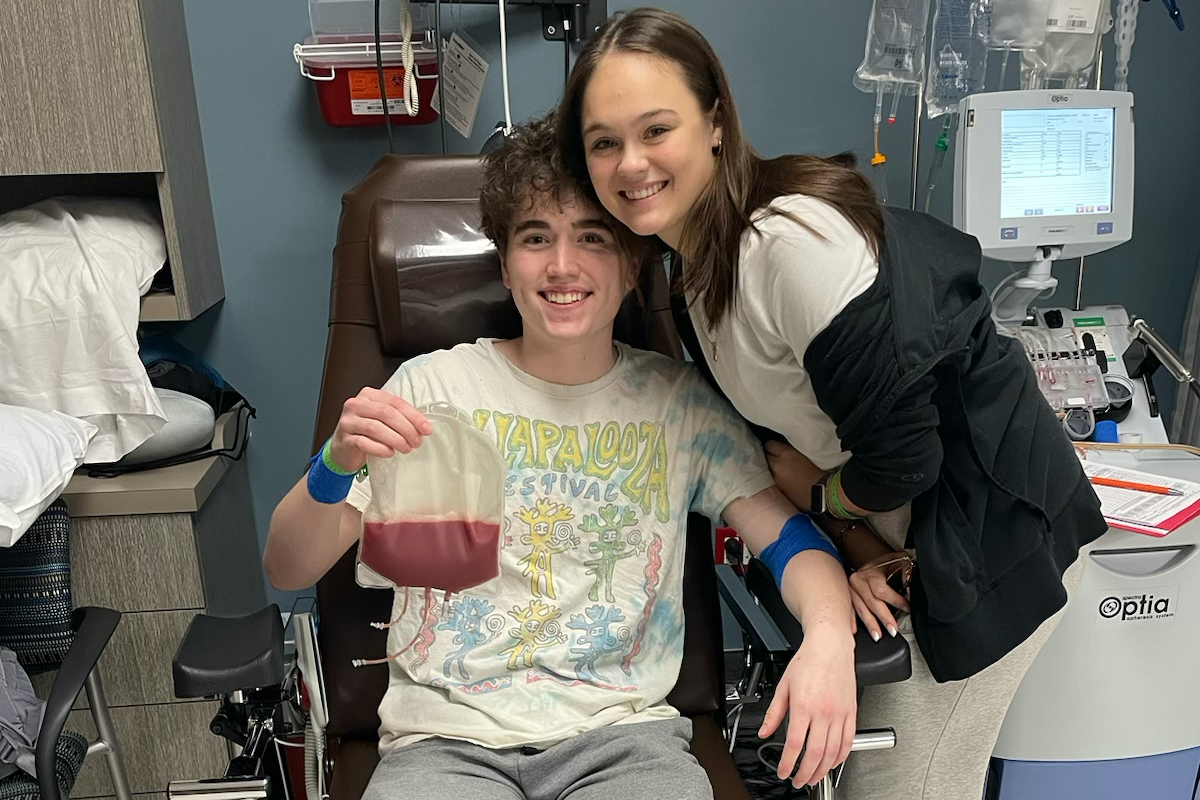 DePaul sophomore Andrew Richardson donated blood stem cells through the Be the Match Registry. His girlfriend, Olivia Gardner, inspired his donation. (Image courtesy of Olivia Gardner)
DePaul sophomore Andrew Richardson donated blood stem cells through the Be the Match Registry. His girlfriend, Olivia Gardner, inspired his donation. (Image courtesy of Olivia Gardner)
During their first quarter as DePaul students, Andrew Richardson and Olivia Gardner met in the dorm and connected immediately. When Richardson learned Gardner needed a bone marrow transplant to cure aplastic anemia, he didn't hesitate to join the national Be the Match Registry.
Richardson swabbed his cheek and mailed in the sample. Late last year, he matched with a patient waiting for a transplant. Only 30% of patients are able to find a match within their families, and the remaining 70% search the
Be the Match Registry in hope of finding a donor.
After the initial disappointment that he hadn't been a match for Gardner, Richardson's next move was clear. He would make the donation and continue momentum to recruit more potential donors through Be the Match. Every year, about 12,000 patients are diagnosed with blood cancers or blood diseases that can be cured by a blood stem cell or marrow transplant.
"I knew I wanted to bring Olivia to be with me during the donation," says Richardson, now a sophomore studying marketing in DePaul's Driehaus College of Business. "It was special to be with her, so she could see what the other side will be like when she gets a match."
They flew to Houston in February, where Richardson donated blood stem cells over the course of two days.
College students are at the ideal age to join the Be the Match Registry, as doctors prefer younger
donors ages 18-35 who are most likely to deliver positive outcomes for patients in need of a transplant. A quick cheek swab is all it takes to join the registry, but thousands of patients are still waiting for a lifesaving match. Last year, DePaul Nursing students helped
recruit more than 6,000 people to the registry through drives and initiatives in diverse communities.
Waiting for a match, hoping for the future
Gardner was diagnosed with
aplastic anemia in high school and since then has endured rounds of medical treatments, transfusions and hospitalizations.
"There have been a lot of bumps in the road. I was septic. I had to get my gallbladder removed. There have been a lot of complications and a lot of near-death experiences that were really scary for my family," Gardner says.
For now, her health is stable, but only a transplant from a matching donor can cure the disease.
"It was really emotional being with Andrew during the donation," she says. "For the recipient, it's called a re-birthday, and it's a huge deal."
In a
recent post on TikTok, Be the Match followed the couple's donation journey in a Valentine's Day-themed post.
For Richardson, the process of donating was nearly painless. For five days leading up to the trip, he received at-home injections to boost stem cell production. The donation process was non-surgical, similar to donating plasma, as a machine filtered his blood to remove his blood-forming stem cells.
"There's a myth that stem cell donation is a painful process, and it is not," Richardson says. "I was watching TV and napping, just kind of chilling out. Everyone who worked with us was so nice and helpful."
Be the Match assigns donors a staff person to guide them through the donation process and cover travel expenses. Before heading back to Chicago, Richardson quickly recovered and was even swimming in the hotel pool. Donors and recipients must wait one year before deciding whether they'd like to meet each other. Richardson says he's open to it.
As she navigates life with a chronic, life-threatening illness, Gardner is making plans just like any college student. She's becoming certified in American Sign Language and is exploring careers where she can help people. Richardson is interested in advertising and real estate, and they're making spring break plans to escape the Chicago cold. They urge friends and classmates alike to learn more about joining the registry.
"A lot of times, people may look at Be the Match and think maybe they'll look into it when they're older," Gardner says. "But now is the time."
How you can help
Individuals ages 18-40 years old can request a kit to be mailed to their home by visiting
https://my.bethematch.org/ForOlivia. A simple swab of each cheek is all that is required to join the registry—where potential donors' human leukocyte antigens are compared with those of thousands of waiting patients, including Gardner's. Potential donors are only called for further testing if identified as a match for a patient in need of a transplant.
Kristin Claes Mathews is assistant director of news and integrated content in the University Marketing and Communications division.